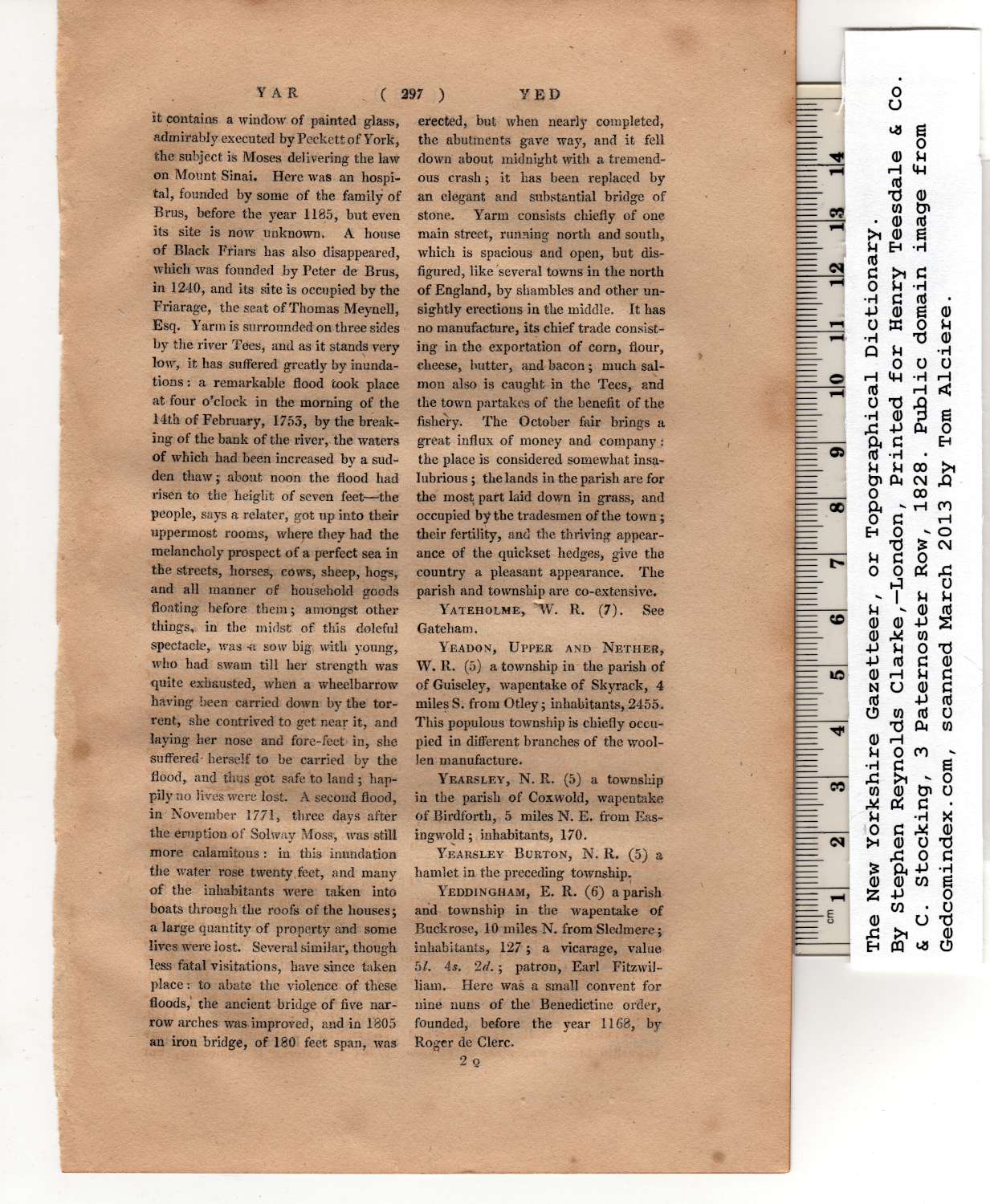|
it contains a window of painted glass,
admirably executed by Peckett of York,
the subject is Moses delivering the law
on Mount Sinai. Here was an hospi-
tal, founded by some of the family of
Brus, before the year 1185, but even
its site is now unknown. A house
of Black Friars has also disappeared,
which was founded by Peter de Brus,
in 1240, and its site is occupied by the
Friarage, the seat of Thomas Meynell,
Esq. Yarm is surrounded on three sides
by the river Tees, and as it stands very
low, it has suffered greatly by inunda-
tions ; a remarkable flood took place
at four o’dock in the morning of the
14th of February, 1753, by the break-
ing of the bank of the river, the waters
of which had been increased by a sud-
den thaw; about noon the flood had
risen to the height of seven feet—the
people, says a relater, got up into their
uppermost rooms, where they had the
melancholy prospect of a perfect sea in
the streets, horses, cows, sheep, hogs,
and all manner of household goods
floating before them; amongst other
things, in the midst of this doleful
spectacle, was -a sow big with young,
who had swam till her strength was
quite exhausted, when a wheelbarrow
having been carried down by the tor-
rent, she contrived to get near it, and
laying her nose and fore-feet in, she
suffered' herself to be carried by the
flood, and thus got safe to land ; hap-
pily no lives were lost. A second flood,
in November 1771, three days after
the eruption of Solway Moss, was still
more calamitous: in this inundation
the water rose twenty feet, and many
of the inhabitants were taken into
boats through the roofs of the houses;
a large quantity of property and some
lives were lost. Several similar, though
less fatal visitations, have since taken
place: to abate the violence of these
floods,' the ancient bridge of five nar-
row arches was improved, and in 1805
an iron bridge, of 180 feet span, was
erected, but when nearly completed,
the abutments gave way, and it fell
down about midnight with a tremend-
ous crash; it has been replaced by
an elegant and substantial bridge of
stone. Yarm consists chiefly of one
main street, running north and south,
which is spacious and open, but dis-
figured, like several towns in the north
of England, by shambles and other un-
sightly erections in the middle. It has
no manufacture, its chief trade consist-
ing in the exportation of corn, flour,
cheese, butter, and bacon; much sal-
mon also is caught in the Tees, and
the town partakes of the benefit of the
fishery. The October fair brings a
great influx of money and company:
the place is considered somewhat insa-
lubrious ; the lands in the parish are for
the most part laid down in grass, and
occupied by the tradesmen of the town;
their fertility, and the thriving appear-
ance of the quickset hedges, give the
country a pleasant appearance. The
parish and township are co-extensive. |
Yateholme, W. R. (7). See
Gateham,
Yeadon, Upper and Nether,
W. R. (5) a township in the parish of
of Guiseley, wapentake of Skyrack, 4
miles S. from Otley; inhabitants, 2455.
This populous township is chiefly occu-
pied in different branches of the wool-
len manufacture.
Yearsley, N. R. (5) a township
in the parish of Coxwold, wapentake
of Birdforth, 5 miles N. E. from Eas-
ingwold; inhabitants, 170.
Yearsley Burton, N. R. (5) a
hamlet in the preceding township.
Yeddingham, E. R. (6) a parish
arid township in the wapentake of
Buckrose, 10 miles N. from Sledmere;
inhabitants, 127; a vicarage, value
5/. As. 2d.; patron, Earl Fitzwil-
liam. Here was a small convent for
nine nuns of the Benedictine order,
founded, before the year 1168, by
Roger de Clerc.
2-o |
